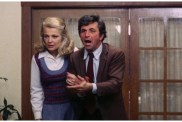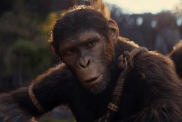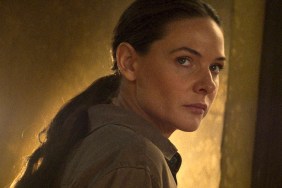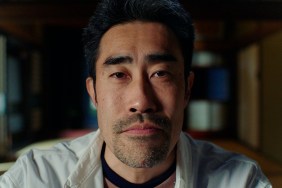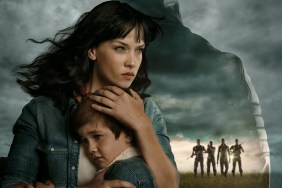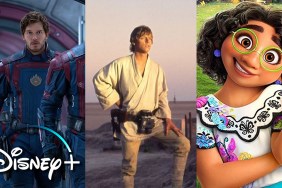Death’s design strikes a fifth time

The appeal of the “Final Destination” series is an obvious one: What would happen if you were present at a horrible catastrophe and by some stroke of fate or luck, you survived while hundreds of others died? You miss your plane or train then find out it’s crashed killing everyone on board. You get off a roller coaster before it derails. You’re sitting in the bleachers at a NASCAR race and something goes horribly wrong⦠alright, maybe that last one will only appeal to certain people. But the movies are always been about that instinctual decision to leave a situation thereby skirting “death’s design” that it’s your time to die, and risking fate trying to rectify the situation by killing you in some other wayâusually one that’s far worse and gruesome than how you might have died originally.
It’s the type of existential question big enough for New Line to have produced four “Final Destination” movies, all which did decently in theaters but have found even more life on DVD and cable. The fourth movie The Final Destination introduced 3D to that world, but its follow-up, called simply Final Destination 5, promises to up the ante on many of the things that worked in the first three movies.
Late last year ShockTillYouDrop.com went up to Vancouver to visit the set of the movie and got to talk to producer Craig Perry, new director Steve Quale, and most of the cast which includes many familiar faces in Nicholas D’Agosto, Emma Bell from “Frozen,” comic actors David Koechner and P.J. Byrne, Arlen Escarpeta from “Friday the 13th” and others.
Before we get to our report, we wanted to let anyone going to this year’s Comic-Con know about a special party for Final Destination 5 being held by New Line and Warner Bros. this year on Thursday night, and we’re offering entry for one winner and a guest to attend the party, which you can read more about here.
As had been revealed in the already-released teaser and trailer, the film begins with a huge set piece of a suspension bridge under construction that’s hit with a gust of wind that causes it to buckle and start collapsing. This time around, it’s the members of an office supply company on a bus heading to a work-related team-building retreat who just happen to be crossing the suspended bridge when Death’s design strikes. Due to a premonition by one of them, they survive.
From the moment we arrived on set, it was obvious this was going to be a much bigger movie than the fourth installment, as well as one that pays as much attention to the storytelling and character dynamics as it does to the absolutely gory deaths filmed in what’s like to be some of the best-looking HD-3D. Wait, don’t change the channel just yet, because while this may be the second movie in the franchise filmed in 3D, this time they’ve hired someone who is intimately familiar with the technology, and that’s because director Steve Quale has worked closely with James Cameron on developing that 3D technology.
One of the things about this set visit compared to others is that everyone was being really, really careful about giving stuff away, which means we left the set not knowing that much more about the movie than we did going in, something that rarely happens. Maybe it was for the better since our enjoyment of the last movie may have been hindered about knowing too much going in.
What really should get long-time fans of the “Final Destination” movies pumped is the return of Tony Todd for the first time since the second movie, once again playing the nameless all-knowing undertaker who seems to be tuned into Death’s plans and how they can be escaped. Besides appearing in the first two movies, Todd is also known for playing the “Candyman” character in that more underrated horror franchise. (Not to put any ideas into any heads, but the fact that the original Candyman hasn’t been remade yet is surprising.) Unfortunately, he wasn’t on set the day we were there.

Masterminding Death’s Design
Once again, we were greeted on our arrival by our gracious host, producer Craig Perry, who has been the only consistent factor between all five movies. Because of that, Perry knows more about what the fans want from a “Final Destination” movie than anyone else. Perry was thrilled to be bringing the franchise back to Vancouver after shooting the fourth part in New Orleans, partially because it meant having the experienced crews that helped make the first three movies, including Visual FX Supervisor Ariel Shaw and Make-Up FX Specialist Toby Lindala who both worked on Final Destination 3.
An even more surprising return to the series was the giant mechanical gimble that was used to create the turbulence for Flight 180, the airplane that blows up the very first Final Destination. For the new movie, that hydraulic gimble was brought out of storage to support and animate a smaller chunk of the suspension bridge that had been built inside the soundstages and would be used to shoot close-ups on a few of the early deaths. They had already shot quite a bit of aerial footage of the actual Lionsgate Bridge in Vancouver, as well as building an 800-foot section of the bridge at a Vancouver location known as Brunswick Pit, which is 250 feet above the ocean
Perry always makes himself readily available on his sets, and he’d check in regularly and amiably field questions about what was going on. The following can be seen as “Craig Perry’s Greatest Hits” on this particular visit, as he talked about where the franchise is at with the fifth movie and some of the decisions made going into it, partially based on the reaction to the fourth movie:
Q: Can you talk about the general concept going into this one?
Craig Perry: We have a couple of interesting things we’ve added to the mix here, but I think more than anything, the scope of the opening sequence is going to really take people by surprise. We’ve been able to capture what is a $150 million scope of a movie on a far, far less scale budget both with Steve’s guidance, having done so many of these big movies, and also the sort of careful allocation of resources. One of the things about this franchise that we’ve discovered is that yes, there’s this spectacle of the opening sequence, but there’s also the minutia that can also deliver the same dividends.
Q: How did you decide about starting the movie on a suspension bridge?
Perry: Having gone on the Lionsgate Bridge to scout this thing, you can feel it move when the cars travel by. It is the most bowel-loosening thing you can imagine because you actually have that sense of movement and vertigo because they don’t have the skyhigh curbed-over suicide railings. You’re very immediately 300 feet off the ground. When you’re doing an angle and you’re traveling 65 miles an hour, you’re like “I shouldn’t be this high up! I’m like in a plane here.,” and it’s very weird. Everybody has had that moment when they are on either an overpass or a bridge and they think, “I shouldn’t be this high up in a car. There’s nothing good about this.” There are also certain places when you get stuck in traffic and you happen to be on the crest of the bridge, that’s when you really start to feel it. “There’s nowhere I can go! If something were to go wrong, what do I do? Do I fall? Do I get out? Do I run? I can only do so much.” We extrapolated from that innate sense of “I don’t think I should be doing this. Human beings aren’t meant to be doing this activity.” As we researched, there was an anecdote where there are people that have this phobia about being on bridges and there are people who are stationed to drive you. If you pull over, they will drive your car to the next station because you can just sit there cowering until you get to the next side. To me, that cemented that this is something that people will understand and get. One of the things evidenced by this is that we’ve been able to definitely capitalize on that vertigo of crawling across things that are way above a deep abyss beneath you as well as capturing the 3D component of that distance.

Q: Is this movie starting a new series and will there be any sort of manifestation of Death?
Perry: We’ll never do a manifestation of death. That’s one of the things that we have distinguished ourselves from other franchises by not personifying death. Every culture has an embodiment of what death or mortality is. By us not putting an image to it, they can ascribe their own culture to it, and it very easily assimilates. I think that’s why we did so well worldwide; it was really able to speak to everybody’s sense of what death means without having it be specific. I think that’s an interesting byproduct of the initial decision to not personify it. Now people have debated endlessly on websites such as your own whether Tony Todd is the personification of death. I’m not answering that. I will not answer that âcause I like the fact that there’s a debate back and forth as to what he does represent. You’ll have to ask Tony because, obviously, he’s created this character and he knows who this guy is. Well, he won’t tell you either, but he does know. He’s not telling. I like the fact that we are having Tony Todd back for this one, because I think it helps bring the franchise sort of full circle. We are really sort of coming back together. It’s not about a reboot, but let’s look at this same premise from a slightly different perspective. I’m not going to give away any of the things that we’ve come up with, but there are some things that I think will reinvigorate what is a ten-year franchise in a way that will keep the fans happy but I think it will also allow us to tell more and more stories in this environment.
Q: What about whatever is allowing one person to have a premonition of the disaster that allows them to escape the original disaster?
Perry: One could make the argument that whatever is allowing people to be clairvoyant or to have this premonition, who’s to say that it’s necessarily a malevolent force? It does save people in one regard at first. I think that one of the things that we were looking to explore but I don’t think did as effectively as maybe we could have is the idea that there is potentially an opposing force to whatever death may be. There’s both sides of it. Ultimately, this is a franchise about death coming back to take people who have escaped their fate, but there’s a cultural mandate to explore both sides of that equation, and I think that touch on that lightly here, because that’s not what it’s really about, but I do think if you just hint at some of these theological debates, these issues that people wrestle with, I can’t help but think it’s only going to help make the movie better by making the deaths have more impact for the characters. You want this to be about characters you engage with being put in circumstances you wouldn’t want to find yourself in, and then terrible things happen. Let’s be honest, that’s the trajectory of the movie. Endeavoring to make it smarter is never bad.
Q: Will this franchise just keep going until fans say they’ve had enough or is there an ending in sight that this might be leading up to?
Perry: First off, you don’t call a movie that is destined to have sequels “Final Destination”. Really bad idea. Just so you know. But we were fortunate enough that people responded and we were able to make more and go from there. I feel though that given the nature of the premise if you suddenly reveal the wizard behind the curtain, you will inevitably fail. You will never live up to anybody’s expectations of what it could be, which goes back to the idea that you can’t see what that looks like. I don’t think this is like “Lost” where we are taking people down the primrose path, but I feel it’s going to be a continual rumination on how different people react to dire circumstances, to death, and to force people to look at the day to day things they do that may cause them grievous, hateful bodily harm and find some pleasure both in watching somebody do it and then hopefully preventing it yourself when you leave. If these movies can continue to do that, the take-home factor is going to keep us going.
Q: When you did “The Final Destination,” was the idea that it was going to be the end of the franchise?
Perry: I give credit to Bob Shaye. I think he was the only one who said “I think there’s a franchise here” even before we started shooting. He’s a smart business man, and he was thinking about “How do you carry this thing through?” but you never want to be that presumptuous to think, “Oh, this will launch a franchise.” Unless you’re making “Transformers” which is already a branded piece of material, you usually back into it, luck out. You realize, “Wow, people responded to it. Is there more to do? Can we do something else?” The odd thing about this franchise is that there is the definite formula and I think it’s a formula if you deviate too far from you sort of alienate a certain section of people who like these movies. Similarly, you don’t want to make a complete regurgitation of it so the challenge is to find the one or two things that distinguish the movies sequentially but don’t become like “Lost.” There will be people who watch all four in one weekend and it’s an interesting experience to talk to somebody who sees them back to back and they do see this gradual building of a substructure of both mythology and visual references and verbal references and callbacks and echoes so there’s pleasure to be had. Who knew?
In Part 2, we talk to Steve Quale, director of Final Destination 5.
Source: Edward Douglas

